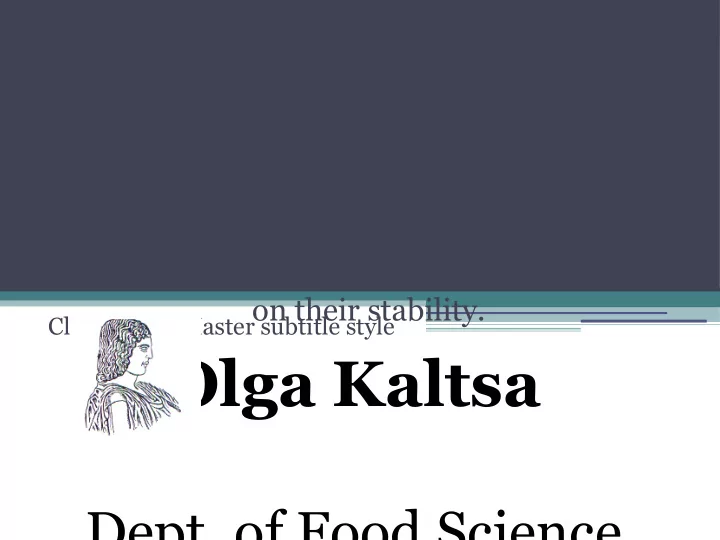

Production of fine o/w emulsions with whey proteins and various gum stabilizers. Effect of ultrasonic emulsification parameters on their stability. Click to edit Master subtitle style Olga Kaltsa Dept. of Food Science
Presentation structure • Introduction :Ultrasonic emulsification • WPC emulsions pH 7 – Stabilizers (model emulsions) • WPI emulsions pH 4 –Time & Amplitude (similar conditions with dressings)
Food design : not only calories
Ultrasonic emulsification 1st report, Wood & Lumis 1927 • 1st patent, Zurich 1944 • High frequency Generator (20kHz) Ultrasonic horn Coarse emulsion D~10-20μm Pressure gradients: deformation of droplets Negative pressure cycle elongation Compression cycle collapse of cavitation bubble
Ultrasonic emulsification Advantages (+) Vs Conventional methods Small droplet (up to 200nm), narrow distribution increased • stability Little or no surfactant • Power efficiency • Process considerations Rheology limitations (continuous/dispersed phase viscosity, • polymer degradation) Over-processing (re-coalescence) • Thermal denaturation (e.g. proteins) •
WPC model emulsions, ph 7 Coarse emulsions : 3% WPC, 20% olive oil, 0.25 & 0.5% gums: • -Xanthan (XG) -Guar (GG) -Locust bean (LBG) Sonication : • -method A 70% amplitude/2min (~11.5 kJ) -method B 70% amplitude/3min+90%-1min (~25.7 kJ) Analysis • Multiple light scattering (MLS), Diffusion NMR, Light Microscopy, Stress-controlled rheology.
Microstructure XG GG LBG • Ultrasound disrupts gum 0.25% flocs Method A • 0.25%weak 0.5% structure, induce depletion flocculation • 0.5% stronger 0.25% network, fewer Method B gaps, methods A&B similar 0.5% structure
Oil droplet size Gum concentration affects • Method A Method B droplet size (method A), D50 (μm) D50 (μm) % Gum viscosity limitation 1.107a 0.832a 0.25 method B D50<1 μm XG • 1.325b 0.786a 0.5 1.093a 0.843a 0.25 LBG most effective in • GG 1.330b 0.771a reducing droplet size 0.5 1.018c 0.876a 0.25 LBG 1.077a 0.615b 0.5 XG 0.5% (A)
Effect of sonication method on emulsion viscosity Viscosity:XG>LBG>GG • Increase of sonication • time and amplitude (method B) reduces viscosity XG: k 2.2080.859 n 0.4070.534 Viscosity of emulsions containing 0.5% gums
Stability of 0.25% emulsions Xanthan, more stable • emulsions, Creaming Index follows viscosity trend XG<LBG<GG Increase of time and • amplitude decreased stability (XG) A B Creaming evolution of 0.25% emulsions (10days/5oC) XG 0.25%
Stability of 0.5% emulsions XG GG LBG Decrease of back • BS (%) scattering (dBS)ƒ(time) time 1 1 1 0 0 coalescence 0 8 8 8 0 0 0 0 0 0 6 6 6 Method A 0 0 0 4 4 4 Method B 0 0 0 • 2 2 2 0 0 0 0 -no significant influence for 0 0 Tube length (mm) Tube length (mm) Tube length (mm ) XG, D50 1.3 0.8 μm BS (%) 5 0 0 0 (dBS 1.301.06%) 1 1 1 5 5 0 0 0 0 8 8 8 0 0 0 0 0 0 0 0 Method B 6 6 6 0 0 0 -for GG, LBG improved 4 4 4 0 0 0 2 2 2 droplet coalescence, smaller 0 0 0 0 0 0 droplet size Tube length (mm) Tube length (mm) Tube length (mm) 5 5 5 0 0 0 0 (GG :dBS 8.651.31%, 0 0 Back scattering profiles of 0.5% emulsions (10days/5oC) LBG:dBS 8.990.90%)
WPI emulsions, ph~4 Coarse emulsions : 2.7% WPI, 20% olive oil, 0.25%XG Energy input • Ultrasonic emulsification treatments linear regression • with amplitude & - 40 to 100% amplitude (constant time, 1min) time - 1 to 4min (constant amplitude, 70%) Temperature rise Power law trend Energy release and temperature rise as a function of sonication amplitude and • time
Effect of sonication on viscosity Viscosity properties as affected by sonication • treatment Sonication k n treatment (Pa-s^n) (-) No Ultra 24.00 0.181 40%-1min 11.16 0.196 60%-1min 4.37 0.309 80%-1min 3.18 0.331 100%-1min 2.58 0.354 70%-1min 4.12 0.308 70%-2min 2.38 0.359 70%-3min 1.49 0.420 70%-4min (-)* (-)* Influence of sonication treatment on the viscosity *Power law model not applicable of 1% XG solutions. (100%-1min) similar effect with (70%-2min) 10 times reduction of K, • 3 times increase of n (less shear-thinning) •
Effect of sonication on droplet size Disruption is a kinetic event thus, • 100% a minimum sonication time is required to achieve droplet disruption 40% Temperature rise facilated droplet • disruption Higher amplitude and extended • time leads to larger droplet 4min disruption (D43) 40% D50 1.583, D43 4.530 • 1min 100% D50 0.982, D43 1.793 • 1min D50 1.242, D43 2.776 • 4min D50 0.878, D43 1.268 • Influence of sonication treatment on droplet size
Effect of sonication on creaming • Increase of amplitude and time decrease CI • Small increase of CI at 4min more related to viscosity reduction, droplet size was reduced CI% Droplet Viscosity size Influence of sonication treatment on stability during storage
Effect of sonication on creaming 3 min (70%) CI 4.16%, 17.6 kJ 40% 100% 2min (70%) CI 7.25%, ~11.7kJ 100%(1min) CI 7.2%, ~8.4kJ 1min 4min 28% Power saving 50% Process time Creaming Index (on day 10) as a function of sonication • treatment.
Influence of NaCl addition 0 mM NaCl CI 29.5% • 100 mM NaClCI 19.8% • “The addition • of electrolytes, such as sodium • increases the viscosity and stability, 0.1% salt for optimum Effect of NaCl addition (method B sonication) viscosity”
Current work • AUA: Incorporation of different fractions of fenugreek galactomannans (coarse or purified from protein). Effect of sonication on surface tension properties. • WUR : Olive oil sub-micron emulsions (WPI& low molecular weight emulsifiers, LbL technique) Evi Paximada, Elke Scholten, Erik van der Linden.
Thank you! Questions? • This research has been co-financed by the European Union (European Social Fund – ESF) and Greek national funds through the Operational Program "Education and Lifelong Learning" of the National Strategic Reference Framework (NSRF) - Research Funding Program: Heracleitus II. Investing in knowledge society through the European
Recommend
More recommend